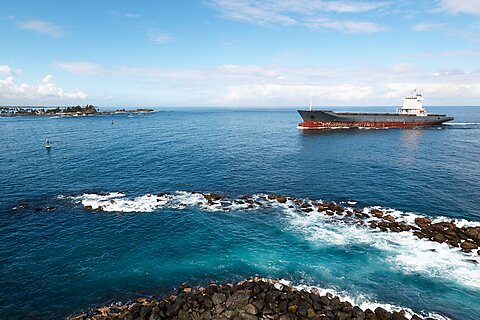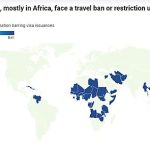
Colin Grabow
Perhaps no part of the United States is more impacted by the Jones Act than Puerto Rico. Thanks to the 1920 law, the struggling territory’s approximately 3.2 million people must use some of the world’s most expensive shipping for commerce with the US mainland (by far its top trading partner). One would intuit such protectionism inflicts no small cost to the island’s economy given its heavy dependence on ocean transport. But exactly how significant is it?
A recently released working paper from two Purdue University economists may have gotten us closer to the answer. Authored by Russell Hillberry and Manuel I. Jimenez, the paper finds that the Jones Act imposes an annual welfare burden on Puerto Rico of $1.4 billion. And that, they add, might be on the low side.
The paper focuses on an oddity within Puerto Rico shipping. Unlike most vessels transporting goods to the island and its Caribbean neighbors, those operating under the Jones Act—which requires vessels engaged in domestic transportation to be US-flagged and US-built—consist almost entirely of containerships and barges. Other vessel types such as dry bulk ships, tankers, and general cargo ships used to haul heavy and bulky items not easily placed in containers are either absent from the US-Puerto Rico trade or exceedingly rare.
The authors posit that this phenomenon is due to the economics of operating under Jones Act restrictions—particularly for dry bulk ships. After unloading their cargo in Puerto Rico, such vessels typically would—akin to a taxi that has dropped off its passenger—immediately search for new goods to haul. Unable to compete for cargo in nearby international ports due to their high costs, however, Jones Act vessels would face an empty, money-losing trip back to the US mainland. The math doesn’t work, so such vessels rarely serve Puerto Rico (none in the specific case of oceangoing dry bulk ships, as they do not exist in the Jones Act fleet).
For Hillberry and Jimenez this raises an interesting question: how high would a tariff have to be to produce such a drop in demand for these vessel types? Their answer: 30.6 percent. Such a de facto tariff, they calculate, implies an annual welfare burden of $1.4 billion.
The largest component of this figure is the Jones Act’s cost to Puerto Rican consumers, which they place at $692 million (about $203 per person) annually. For comparison, the economists estimate that most favored nation tariffs (default rates the US applies to other World Trade Organization member countries) applied to Puerto Rican imports cost the island’s residents $94 million ($28 each per year). The Jones Act’s financial damage to Puerto Rican households exceeds that of US tariffs by a factor of seven.
The other elements of the $1.4 billion welfare burden, meanwhile, are a $291 million charge to Puerto Rican exporters in the form of costlier inputs and a hit to investment of $403 million.
But as Hillberry and Jimenez explain, the law’s costs may well go higher. They point out, for example, that for upstream products—inputs used in the production of final goods—there is “a large bias against sea-shipped products from all sources.” That finding, the economists state, “is consistent with [the Jones Act] having shifted the structure of [Puerto Rico’s] production away from processing sea-shipped inputs over the long run” (although they add that other policies may have also contributed to the outcome).
In other words, there is good reason to think the high cost of Jones Act shipping—and possibly other factors—has distorted Puerto Rico’s economic development by rendering certain industries unviable. Indeed, such suspicions are rooted not only in economic theory but Puerto Rican history.
In 1961 congressional hearings Teodoro Moscoso, the head of a Puerto Rican government initiative tasked with sparking the island’s industrialization, testified that high Jones Act shipping rates had placed industries involving heavy and bulky raw materials or finished products “almost out of the question.” These high rates, he added, meant that Puerto Rico had been limited to “light manufacturing, to electronics, light metal manufacturing, and things of that kind which, of course, hampers us tremendously [emphasis added].”
The Purdue economists further state that the Jones Act’s $403 million cost to investment—an implicit tax of 3 percent—implies that the law “imposes dynamic losses on [Puerto Rico] that are likely much more consequential” than their static estimates.
This raises an important point. A true accounting of the Jones Act’s burden on Puerto Rico must include not only the law’s immediate costs but also its knock-on effects.
Higher energy costs due to the Jones Act, for example, mean the island must either raise electricity prices (higher on average than any US state except Hawaii, which is similarly burdened by the Jones Act as well as extreme geographical remoteness) or cut costs elsewhere, such as through deferred maintenance. Higher electricity prices or an unstable grid—both of which are no strangers to Puerto Rico—in turn deter investment and other economic activity.
Between such dynamic losses and the distortions to Puerto Rico’s economic development, one cannot help but wonder what might have been—and what might be still—if the island could transport goods to and from the world’s largest economy using efficient international-flagged shipping.
Hillberry and Jimenez’s new paper, meanwhile, is just the latest addition to a body of recent literature confirming the Jones Act’s harm to Puerto Rico. Reports prepared by economic consultants in 2019 found the Jones Act to raise prices on the island by $1.1 billion and by $367 million on food and beverages alone, while a 2012 academic study found a cost of $537.2 million (2010 dollars).
In addition, a 2015 report by three economists including Anne Krueger, a former chief economist at the World Bank, identified a Jones Act exemption for Puerto Rico as a means of sparking growth, and a 2020 Rand Corporation report on Puerto Rico’s economy cited the Jones Act as one of five main impediments to economic growth.
Of course, any analysis of the Jones Act’s application to Puerto Rico must also balance such costs against its benefits for the US maritime industry. These, however, are underwhelming at best.
While the law theoretically generates ships and mariners for military sealift purposes, as well as steady work for US shipyards, only five Jones Act-compliant ships regularly serve the island. Furthermore, one of those five wasn’t even built in the United States (the National Glory, which operates between Houston and San Juan, was constructed in a Polish shipyard but is permitted to operate under the Jones Act after being seized in a drug bust and auctioned off by the US government).
The remainder of Jones Act commerce with Puerto Rico is handled by tugboats and oceangoing barges not used for strategic sealift and whose crews lack the necessary licenses to serve on sealift ships.
If one conservatively pegs the Jones Act’s annual cost to Puerto Rico at $1 billion, each ship (and their crews) is employed at a cost of $200 million per year. For perspective, the government’s Maritime Security Program annually spends less than $325 million on stipends to ensure the availability of sixty US-flagged commercial ships in times of war or national emergency.
But beyond this gross cost-benefit asymmetry, the Jones Act’s application to Puerto Rico also doesn’t pass muster as a matter of simple fairness. If the Jones Act truly is about meeting national security needs, why is its burden so disproportionately borne by such a relatively small percentage of the US population?
That Puerto Rico bears this cost while facing a poverty rate that exceeds 40 percent, having limited recourse through the political process (the island has no vote for president and its only representation in Congress is a single member of the House of Representatives with limited voting power), and being the only inhabited US territory to which the Jones Act is fully applied (Guam is exempt from the law’s requirement that vessels be constructed in US shipyards while American Samoa, the Northern Mariana Islands, and the US Virgin Islands are all fully exempt) only compounds the injustice.
Hillberry and Jimenez’s paper is just the latest evidence of the toll the Jones Act exacts on Puerto Rico—one that in no way compensates for whatever benefits it generates. Whether evaluated through a cost-benefit lens or as a matter of fairness, the Jones Act’s imposition on the island is indefensible. The time to remove this hardship is long overdue.





